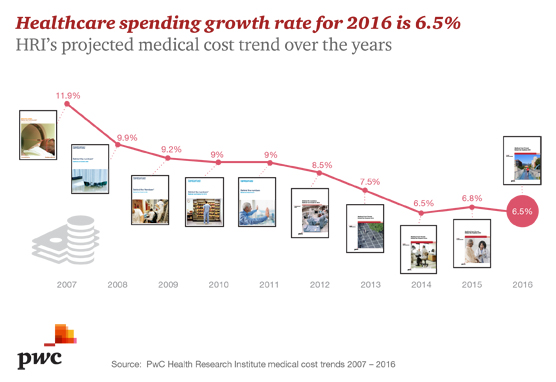![]() PwC’s Health Research Institute (HRI) regularly publishes research and analysis on issues and trends affecting healthcare. In its latest report, Medical Cost Trend: Behind the Numbers 2016, projected spending growth in the $2.9 trillion US health economy is expected to slow this year, but will still likely outpace overall economic inflation. HRI projects medical cost trend for this year to be 6.5%, slightly lower than the 6.8% projected for 2015. The net growth rate in 2016, after accounting for benefit design changes such as higher deductibles and narrow provider networks, is expected to be 4.5%. The report also offers a 10-year look at how medical cost spending will trend in the coming decade.
PwC’s Health Research Institute (HRI) regularly publishes research and analysis on issues and trends affecting healthcare. In its latest report, Medical Cost Trend: Behind the Numbers 2016, projected spending growth in the $2.9 trillion US health economy is expected to slow this year, but will still likely outpace overall economic inflation. HRI projects medical cost trend for this year to be 6.5%, slightly lower than the 6.8% projected for 2015. The net growth rate in 2016, after accounting for benefit design changes such as higher deductibles and narrow provider networks, is expected to be 4.5%. The report also offers a 10-year look at how medical cost spending will trend in the coming decade.
How HRI Makes Projections
From the HRI report: HRI issues its projection for the coming year’s spending growth based on activity in the market that serves employer-based insurance. This projection has become key in setting insurance premiums for the past decade. In compiling data for 2016, HRI interviewed industry executives, health policy experts, and health plan actuaries whose companies cover a combined 100 million members. HRI also analyzed results from PwC’s 2016 Touchstone Survey of more than 1,000 employers from 35 industries.
Key Findings from the Report
Three factors “deflate” medical cost trend in 2016:
- Looming “Cadillac tax” accelerates cost shift
- Virtual health becomes a valuable tool for primary care
- New health advisers steer consumers to more efficient healthcare
Two factors “inflate” medical cost trend in 2016:
- Speciality drugs fill the FDA pipeline
- Cyber security protection adds a new layer of expense
The ingraphic below charts medical cost trending for the past 10 years.

What’s in store for us in the next 10 years? The HRI researchers say that if we are to continue bending the cost curve healthcare organizations and systems will need to:
- Improve healthcare technology including achieving interoperability, implementing an agile health IT infrastructure, making better use of data analytics, and implementing patient care decision tools.
- Make transparency initiatives successful and encourage consumers to use these tools.
- Develop more affordable care innovations, moving to more virtual healthcare and DIY health tools.
- Encourage competition, which will lead to lower costs.
You can download a free copy of Medical Cost Trend: Behind the Numbers 2016.
